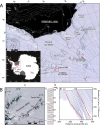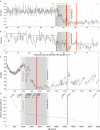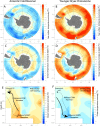Antarctic ice sheet discharge driven by atmosphere-ocean feedbacks at the Last Glacial Termination
- PMID: 28054598
- PMCID: PMC5215443
- DOI: 10.1038/srep39979
Antarctic ice sheet discharge driven by atmosphere-ocean feedbacks at the Last Glacial Termination
Abstract
Reconstructing the dynamic response of the Antarctic ice sheets to warming during the Last Glacial Termination (LGT; 18,000-11,650 yrs ago) allows us to disentangle ice-climate feedbacks that are key to improving future projections. Whilst the sequence of events during this period is reasonably well-known, relatively poor chronological control has precluded precise alignment of ice, atmospheric and marine records, making it difficult to assess relationships between Antarctic ice-sheet (AIS) dynamics, climate change and sea level. Here we present results from a highly-resolved 'horizontal ice core' from the Weddell Sea Embayment, which records millennial-scale AIS dynamics across this extensive region. Counterintuitively, we find AIS mass-loss across the full duration of the Antarctic Cold Reversal (ACR; 14,600-12,700 yrs ago), with stabilisation during the subsequent millennia of atmospheric warming. Earth-system and ice-sheet modelling suggests these contrasting trends were likely Antarctic-wide, sustained by feedbacks amplified by the delivery of Circumpolar Deep Water onto the continental shelf. Given the anti-phase relationship between inter-hemispheric climate trends across the LGT our findings demonstrate that Southern Ocean-AIS feedbacks were controlled by global atmospheric teleconnections. With increasing stratification of the Southern Ocean and intensification of mid-latitude westerly winds today, such teleconnections could amplify AIS mass loss and accelerate global sea-level rise.
Figures




References
-
- Masson-Delmotte V. et al.. In Climate Change 2013: The Physical Science Basis. Contribution of Working Group I to the Fifth Assessment Report of the Intergovernmental Panel on Climate Change (eds Stocker T.F. et al..) Ch. 5, 383–464 (Cambridge University Press, 2013).
-
- Church J. A. et al.. In Climate Change 2013: The Physical Science Basis. Contribution of Working Group I to the Fifth Assessment Report of the Intergovernmental Panel on Climate Change (eds Stocker T.F. et al..) Ch. 13, 1137–1216 (Cambridge University Press, 2013).
-
- Collins M. et al.. In Climate Change 2013: The Physical Science Basis. Contribution of Working Group I to the Fifth Assessment Report of the Intergovernmental Panel on Climate Change (eds Stocker T.F. et al..) Ch. 12, 1029–1136 (Cambridge University Press, 2013).
-
- Joughin I., Smith B. E. & Medley B. Marine ice sheet collapse potentially under way for the Thwaites Glacier Basin, West Antarctica. Science 344, 735–738 (2014). - PubMed
Publication types
LinkOut - more resources
Full Text Sources
Other Literature Sources

